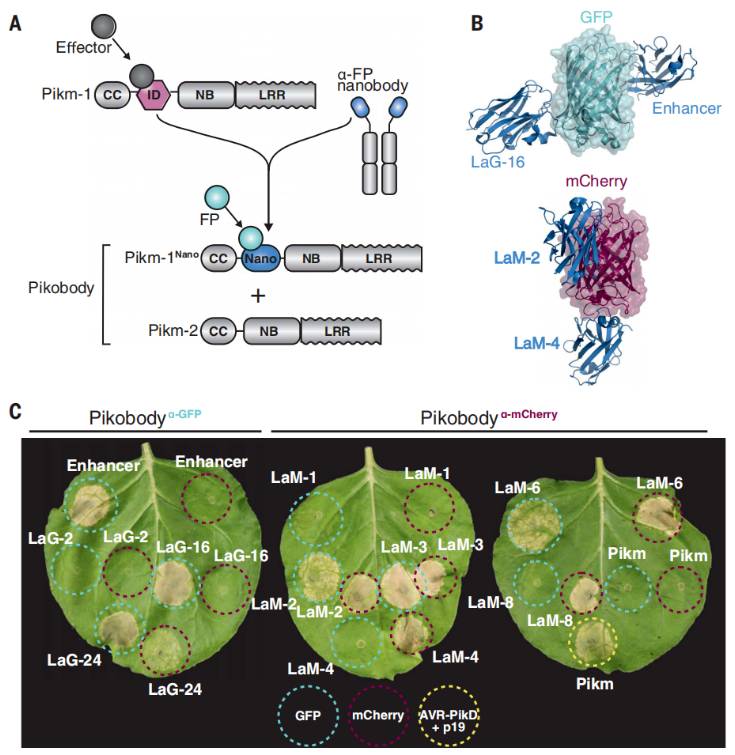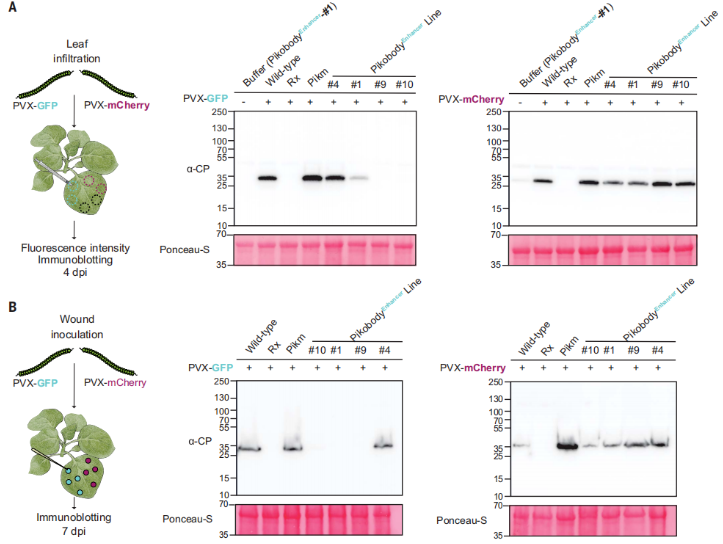On March 2, 2023, Sophie Kamoun's team at the Sainsbury Laboratory of the University of East Anglia in the United Kingdom published a research paper titled "NLR immune receptor–nanobody fusions confer plant disease resistance" in Science. Inspired by the humoral immune system of animals, this study proposes a new strategy for using animal-derived nanobodies to improve plant immunity.
When pathogenic bacteria infect plants, they secrete "effectors" target host proteins that interfere with the plant's immunity. As a countermeasure, plant NLR can recognize some effectors, trigger a strong resistance response, inhibit or even prevent the proliferation of pathogenic bacteria. Some NLRs recognize effectors through their own integrated domain. This integrated domain acts like a bait and can bind to effectors, ultimately activating NLR-mediated immunity. If the integration domain can be replaced so that the integration domain can bind to different effectors, will it be possible to give NLR the ability to recognize different effectors?
To verify this research idea, the authors first expressed two fluorescent proteins, GPP and mcherry, in vitro. Under normal circumstances, these two proteins are not recognized and reacted by NLR. The author injected two fluorescent proteins into alpacas respectively, so that a very small nanobody targeting the two fluorescent proteins would be produced in the alpaca. The sequence of the nanobody was sequenced by mass spectrometry to obtain relevant sequence information. This sequence was then replaced with the integration domain sequence in NLR (Pikm-1) found in rice, and then the modified Pikm-1 was co-expressed with fluorescent protein in Nicotiana benthamiana to observe whether it could induce an HR response. The results show that although not all Nanobodies can do this, Nanobodies can indeed enable NLR to acquire the ability to recognize fluorescent proteins, allowing NLR to recognize fluorescent proteins and cause HR.

To further verify whether this method can enhance plant resistance, the research team used Potato virus X (PVX) expressing GFP and mcherry. When PVX-GFP or PVX-mcherry was co-expressed with the corresponding Nanobody-modified NLR, virus proliferation was significantly inhibited, indicating that modified NLR can indeed enhance plant resistance.
The authors explored the impact of co-expression of different Pikobodies on immune recognition capabilities to determine whether co-expression of different Pikobodies would cause autoimmunity or inhibit recognition. When Pikobody Enhancer and Pikobody LaM-4 are co-expressed in pairs with wild-type Pikm, the HR response is only triggered in the presence of the corresponding fluorescent protein. However, when Pikobody Enhancer and Pikobody LaM-4 were co-expressed, an HR response was triggered regardless of the presence of GFP or mCherry. Co-expression of Pikobody Enhancer and Pikobody LaM-4 resulted in a stronger HR response and significantly reduced the fluorescence intensity of PVX-GFP and PVX-mCherry, further confirming their recognition capabilities. It can be concluded that the additive effect of Pikobody can expand the scope of its recognition and response without causing autoimmunity.
The author introduced the relevant genes of the NLR immune receptor-nanobody fusion into tobacco, and then treated it with the corresponding antigen protein. It was found that the Pikobody Enhancer transgenic plants could show specific resistance to PVX-GFP. This resistance applies not only to PVX-GFP delivered via leaf infiltration inoculation, but also to PVX-GFP delivered via wound inoculation.

In summary, based on the NLR disease resistance system, the authors transferred the animal immune system mechanism to plants and created a plant immune system Pikobody that replaces the ID in the NLR with a nanobody domain to produce a chimeric immune receptor. This system induced immunity well both in transient expression experiments and in stable transgenic tobacco lines. Of course, this immune system still has certain limitations. For example, pathogen proteins need to be delivered into the plant before they can be recognized by the system. However, it still has very broad application value and research significance for generating specific resistance against any pathogen or pest.
Reference:
Kourelis, J., Marchal, C., Posbeyikian, A. et al. NLR immune receptor-nanobody fusions confer plant disease resistance. Science. 2023, 379(6635): 934-939.